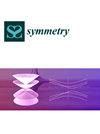利用机器学习和第一性原理计算优化生物相容性非等原子高熵合金的化学成分
IF 2.2
3区 综合性期刊
Q2 MULTIDISCIPLINARY SCIENCES
引用次数: 0
摘要
通过传统的试错方法获得具有优异力学性能和良好生物相容性的高熵合金(HEAs)的合适化学成分仍然是一个巨大的挑战。在此,基于大量的实验数据,可以使用机器学习技术来建立生物相容性HEAs的组成与力学性能之间的关系。随后,进行第一性原理计算以验证机器学习模型预测结果的准确性。HEAs的杨氏模量和屈服强度在之前的实验中得到了很好的预测。此外,还研究了选用具有高晶体对称性的Ti-Zr-Hf-Nb-Ta HEA合金对合金力学性能的影响。最后,机器学习模型预测的Ti8-Zr20-Hf16-Nb35-Ta21 HEA表现出良好的生物相容性和力学性能的结合,这归功于显著的电子流和电荷重组。这项工作揭示了这些策略与机器学习和第一性原理计算相结合在先进生物相容性HEAs开发中的重要性。本文章由计算机程序翻译,如有差异,请以英文原文为准。
Chemical Composition Optimization of Biocompatible Non-Equiatomic High-Entropy Alloys Using Machine Learning and First-Principles Calculations
Obtaining a suitable chemical composition for high-entropy alloys (HEAs) with superior mechanical properties and good biocompatibility is still a formidable challenge through conventional trial-and-error methods. Here, based on a large amount of experimental data, a machine learning technique may be used to establish the relationship between the composition and the mechanical properties of the biocompatible HEAs. Subsequently, first-principles calculations are performed to verify the accuracy of the prediction results from the machine learning model. The predicted Young’s modulus and yield strength of HEAs performed very well in the previous experiments. In addition, the effect on the mechanical properties of alloying an element is investigated in the selected Ti-Zr-Hf-Nb-Ta HEA with the high crystal symmetry. Finally, the Ti8-Zr20-Hf16-Nb35-Ta21 HEA predicted by the machine learning model exhibits a good combination of biocompatibility and mechanical performance, attributed to a significant electron flow and charge recombination. This work reveals the importance of these strategies, combined with machine learning and first-principles calculations, on the development of advanced biocompatible HEAs.
求助全文
通过发布文献求助,成功后即可免费获取论文全文。
去求助
来源期刊

Symmetry-Basel
MULTIDISCIPLINARY SCIENCES-
CiteScore
5.40
自引率
11.10%
发文量
2276
审稿时长
14.88 days
期刊介绍:
Symmetry (ISSN 2073-8994), an international and interdisciplinary scientific journal, publishes reviews, regular research papers and short notes. Our aim is to encourage scientists to publish their experimental and theoretical research in as much detail as possible. There is no restriction on the length of the papers. Full experimental and/or methodical details must be provided, so that results can be reproduced.
 求助内容:
求助内容: 应助结果提醒方式:
应助结果提醒方式:


